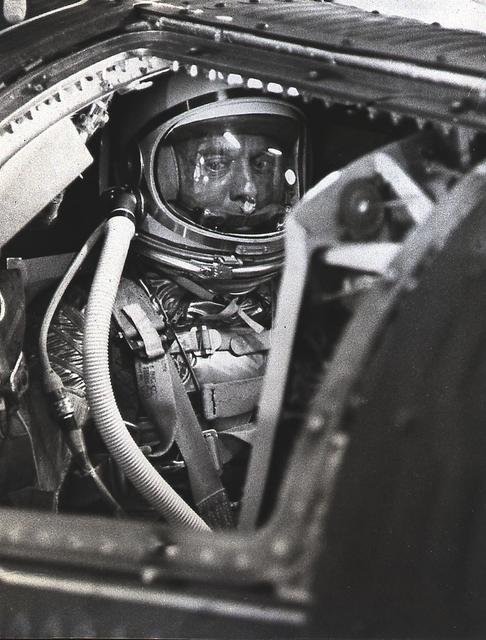
On May 5, 1961, NASA astronaut Alan Shepard Jr. became the first American in space.
59 years ago, Shepard launched into space inside his Freedom 7 capsule. The sub-orbital flight lasted just over 15 minutes, traveled greater than 300 miles, and climbed to an altitude of over 116 miles above the Earth.
He wasn’t the first person to fly in space, that title belonged to Soviet cosmonaut Yuri Gagarin who had orbited the Earth less than a month before Shepard’s flight. However, the Freedom 7 mission did prove that NASA could send humans into space, and that the United States was to be taken seriously as a contender in the heated space race.
To commemorate his historic first flight, we have gathered five fast facts about Shepard and the Freedom 7 mission!
1. Shepard was part of the “Mercury 7.”
The “Mercury 7” were America’s first astronauts, so named for NASA’s first human spaceflight program, Project Mercury. In addition to Shepard, NASA’s first class of astronauts included Gus Grissom, John Glenn, Gordon Cooper, Walter Schirra, Scott Carpenter, and Deke Slayton.
2. Shepard lifted off in a urine-stained spacesuit.
The Freedom 7 mission was supposed to be a quick one. So, preparations had not been made in the event Shepard had to use the bathroom. But when the launch was delayed, Shepard asked to step out to relieve himself. He had been waiting over three hours and needed to go. His request was denied, and Shepard was left with no other option but to relieve himself where he was. There were concerns that the pee would short-circuit the wiring in his suit. However, his cotton underwear absorbed the urine and the mission remained a “go.” This incident caused NASA to develop waste containment systems in newer spacesuits.
3.The entire mission was broadcast on live television.
Unlike Gagarin’s flight, which was largely kept secret, Shepard’s Freedom 7 flight was broadcast for the whole world to see. Millions of viewers tuned in to witness Shepard’s suborbital flight and when the astronaut returned safely to Earth, parades were held to honor him in New York, Washington and Los Angeles.
4. NASA research mathematician Katherine Johnson ran the trajectory analysis for Shepard’s Freedom 7 flight.
Not only did Johnson do the trajectory analysis for NASA’s first human spaceflight, she later ran the extremely important calculations for John Glenn’s historic orbital flight in 1962. Freedom 7 was hailed as a success and the engineers reported that the capsule was in such great shape upon recovery, it could have been used again.
5. A decade after Freedom 7, Shepard golfed on the Moon.
Ten years after his historic flight aboard the Freedom 7, Shepard journeyed to the Moon as the commander of Apollo 14. While on the surface of the lunar landscape he hit two balls with a makeshift golf club, becoming the first, and only, person to play golf on the Moon. He could only use one arm due to the stiffness of his spacesuit but managed to send one of the balls flying roughly 200 yards from where he stood on the Moon. Shepard took the makeshift golf club home, later donating the 6-iron to the U.S. Golf Association Museum. But he left the golf balls behind on the surface of the lunar landscape.
Click here to read more about the first American in space and the Freedom 7 mission.








